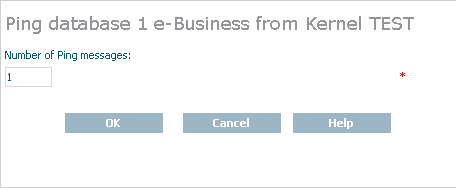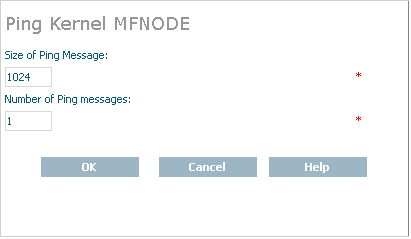You can ping the databases managed by a Kernel and any classic nodes specified in classic connection definitions for the Kernel. Pinging allows you to determine if the database or classic nodes are active.
Note:
Classic connections are connections to an Entire Net-Work 2 for open
systems node, an Entire Net-Work 3 for OpenVMS node or with an Entire Net-Work 6
(mainframe) node that does not have the Simple Connection Line Driver installed.
This document covers the following topics:
 To ping a database managed by a Kernel:
To ping a database managed by a Kernel:
Make sure you have accessed the System Management Hub and that the Kernel is started. For complete information about starting Kernels, read Starting a Kernel.
Select the name of the managed host on which Entire Net-Work Server is installed.
Expand the tree-view frame for the managed host by clicking on the plus sign (+) to the left of its name.
Select "Entire Net-Work Server" in the tree-view under the managed host.
The Entire Net-Work Server administration area of the System Management Hub becomes available to you.
Expand Kernels in tree-view, by clicking on the plus sign (+) to the left of its label.
The list of started Kernels appears.
Note:
If the Kernel you need is not listed, it is not started. You
must start the Kernel before you can proceed with these instructions. Read
Starting a
Kernel for more information.
Expand Databases in tree-view, by clicking on the plus sign (+) to the left of its label.
The databases managed by the Kernel are listed in tree-view.
Right-click on the database you want to ping and select from the resulting drop-down menu.
A Ping panel appears in detail-view.

Specify the number of ping messages that should be sent from the Kernel to the database in the Number of Ping messages box.
Click to start pinging.
The results of the ping attempts appears in detail-view, indicating whether or not the database is active.
 To ping a classic node managed by a Kernel:
To ping a classic node managed by a Kernel:
Make sure you have accessed the System Management Hub and that the Kernel is started. For complete information about starting Kernels, read Starting a Kernel.
Select the name of the managed host on which Entire Net-Work Server is installed.
Expand the tree-view frame for the managed host by clicking on the plus sign (+) to the left of its name.
Select "Entire Net-Work Server" in the tree-view under the managed host.
The Entire Net-Work Server administration area of the System Management Hub becomes available to you.
Expand Kernels in tree-view, by clicking on the plus sign (+) to the left of its label.
The list of started Kernels appears.
Note:
If the Kernel you need is not listed, it is not started. You
must start the Kernel before you can proceed with these instructions. Read
Starting a
Kernel for more information.
Expand Connections in tree-view, by clicking on the plus sign (+) to the left of its label.
The connection definitions for the Kernel are listed in Outgoing and Incoming categories in tree-view.
Expand the Outgoing category to see the list of outgoing connection definitions. Connections to classic nodes are always outgoing from Entire Net-Work Server nodes.
Right-click the classic connection for the classic node you want to ping and select from the resulting drop-down menu.
A Ping panel appears in detail-view.

Specify the size and number of ping messages that should be sent from the Kernel to the classic node in the Size of Ping Message and Number of Ping messages boxes.
Click to start pinging.
The results of the ping attempts appears in detail-view, indicating whether or not the classic node is active.